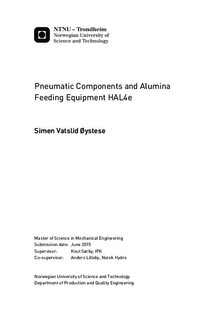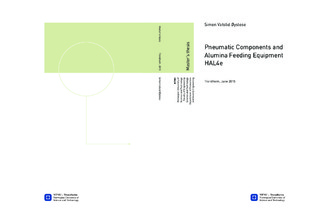| dc.description.abstract | This thesis presents the current design variations and possible solutions for optimisation of the alumina distribution system for the next generation aluminium production cell. The alumina distribution system is of high importance to the production system, as alumina is the raw material in the primary aluminium production. The new cells (HAL4e) are currently operating as six cells in Hydro Årdal with a planned expansion to a 60 cell pilot plant in Hydro Karmøy, 2017. This thesis investigates the distribution of alumina over the cell length of the cell air slide, and the actual feeding of alumina through eight point feeders distributed along cell length.
The alumina transportation is done by fluidisation of alumina, which in short gives the alumina a fluid like behaviour and utilises the fluid head for transportation. Fluidisation is, however, not a binary effect which means that the transportation capacity is dependent on the air velocity used for fluidisation and not only if the velocity is sufficient to reach a fluidised state.
Simulations indicate that a small supply tube for compressed air could lead to a large pressure drop along the cell length for the cell air slide. Specifically this means that an inner diameter of 12 mm, as is present on the L24 and L25 cells, leads to an unstable fluidisation. The optimal design as of today is the Ø15 mm inner diameter pipe used on cell L26 and L27. With the current nozzles, this provides a relatively stable fluidisation velocity despite the small pressure drop. This also leads to a 6 % reduction in consumption compared to the L22 and L23 design that is equipped with a Ø19 mm inner diameter supply tube.
The pressure drop on the L26/L27 design is, however, a factor in the optimisation of the cell air slide. A solution that could lead to a 19 % reduction in consumption is a pressure reduction to 5.5 bar absolute pressure on the air supply. The Ø19 mm supply is in this case optimal due to the marginal pressure drop over the cell length. Measurements carried out as part of this thesis also indicate that the fluidising velocity at 5.5 bar absolute pressure is sufficient to achieve desired transport capacity.
The air consumption is, however, of minor importance on the point feeders due to the marginal flow in the elements. In this case the important factor is the accuracy of doses, which in this thesis is shown to increase with reducing pressure based on measurements carried out at a test rig in Årdal.
As the cell air slide has a higher requirement to the air pressure than the feeders, and since the feeders show improved results for pressure below this limit, implementation of two separate pressure regulators is recommended.
This thesis also suggests a change in the operation of the point feeders. The point feeders are currently operated with a control volume being emptied each cycle. The reduced standard deviation in the doses at 3.0 barg could allow the feeders to operate without this control volume. This way the end effects of each cycle could also be eliminated. Even though this leads to reliable doses, the removal of the control volume still causes a slight increase in standard deviation over time. The increase is small and this thesis, therefore, concludes that a re-evaluation of the operational parameters should be considered.
In general, this thesis concludes that a pressure reduction on the fluidised transportation system is a good solution to increase accuracy and reduce consumption. Further testing in the actual production is, however, required before large-scale implementation. | |

